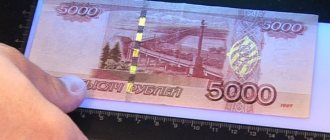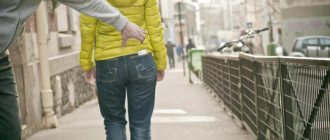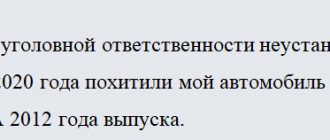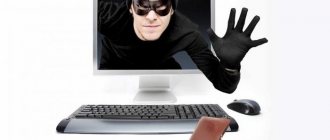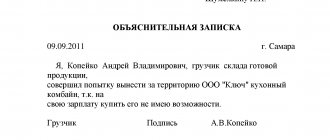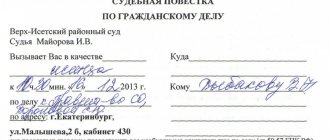In this article, I want to tell you how to behave if you find a counterfeit bill in your wallet, as well as how to act if you were given a counterfeit bill somewhere and you came to another store, paid with it, and when you paid, it was discovered that the bill is counterfeit. You will learn what not to do when you discover a fake and how to deal with a fake correctly.
If the store says your bill is counterfeit
- First of all, ask for the banknote that is in question to be returned to you. Don’t let it be taken away, because in this case the money can be replaced with really counterfeit ones; pay for the food with other bills. Most often, store employees call the police - remain calm and make sure that the bill you handed over is in sight.
- If you have a suspicious bill, contact the bank where it can be checked. There she will be sent for examination, which can last up to 5 days.
- If the bank detects a counterfeit, it will be stamped “Exchange Refused” or “Counterfeit.” Afterwards, the police will be notified, whose employees will conduct an investigation into the discovery of counterfeit money.
How to protect yourself from receiving counterfeit bills
Cashless payments are considered the safest. Money is debited from or credited to the card account. But this method is not suitable for everyone.
To protect yourself from receiving counterfeits, you need to carefully study the security symbols of each banknote.
It is better to exchange foreign currency at specialized exchange offices or banking institutions
. Only they can guarantee that you will receive genuine cash. Yes, the rate at illegal exchangers is higher. But no one guarantees that you will receive original banknotes.
It is better to check cash immediately after receiving it. Protective symbols help with this. You can detect a fake without special equipment by touch.
You should not change banknotes for small or large ones at retail outlets, markets or shops. It is much easier to get a fake in them. You must always be extremely careful when counting large amounts of cash. It is much easier to hide a fake in packs.
Is it possible to hand over counterfeit bills to the police?
Yes, you can take “doubtful” money directly to the police. The station will open a case and conduct an investigation. But you will have to testify; in this case, it is advisable to remember exactly how such a bill came to you.
Important! If you have a counterfeit bill in your wallet or simply have a suspicion that it is a fake, do not under any circumstances try to get rid of it. This could end badly. If you try to get rid of counterfeit goods in a market, store or any other retail outlet, you are deliberately becoming an accomplice to the crime. Remember, Article 186 of the Criminal Code of the Russian Federation “Illegal production, storage, transportation or sale of counterfeit banknotes of the Bank of the Russian Federation” provides for and equalizes the responsibility of both the manufacturer and the distributor of counterfeit money.
How to check that a banknote is real (let's look at the example of the latest modifications)
Principles of protection
The principle of protecting banknotes, like coins, has remained the “arms race” for many centuries. It lies in the fact that money developers must come up with ever newer degrees of protection that counterfeiters still cannot counterfeit. As soon as these new methods are mastered by criminal enterprises, new ones are needed that will be reliable until the next round of this race. The manufacturing technology is a strictly kept secret, and every person involved in any stage of production is responsible if he reveals it to anyone.
Over the last century, the principles of protection have completely changed. This is due to technology development and progress. For example, in the Russian Empire during the reign of Catherine II, the protective function was performed by the signatures of bankers or other officials. If desired, any “craftsman” could fake them. Seals were also used.
Later, various banknote security elements began to be used.
Special paper composition . In most cases, counterfeits are very inferior in durability, since their purpose is not long-term use, but one-time sales. High bending and tensile strength are determined by special instruments. The paper used for printing banknotes does not fade over time as much as other types and is not susceptible to exposure to sunlight.
Water marks. These are designs that appear darker or lighter when held up to light. They are often imitated by counterfeiters. Sometimes they do this in such a way that the image itself is visible, but not noticeable in transmitted light. Sometimes there is a glossy sheen to the paint that shouldn't be there when viewed from an angle.
If a counterfeit banknote is made by gluing two halves together, when checked under ultraviolet light, the halftones will not be visible. Sometimes, for imitation, oil impregnation is used in the place of the watermark. Such places are not detectable in ultraviolet light, but to the naked eye they are very similar to the original.
To enhance protection, elements and details gradually became smaller without losing clarity. This made counterfeit banknote scams easier to spot.
Watermarks are distinguished by position:
- local - an image in a certain place on the bill;
- stripe - a series of identical images that are located one below the other, most often stripe watermarks are placed on a light field along the narrow side of the banknote;
- general - can be in the form of text, ornament or design, which are repeated throughout the entire field of the banknote.
Hologram. A metallized element is produced separately and delivered to the enterprise for pressing into money paper. When viewing the hologram from different angles, one pattern changes to another, creating a volumetric effect.
Security thread . A thin strip of polymer material or metal is inserted inside the paper. This element is clearly visible in the light. There are two different types:
- Implemented. It is also called continuous. It's all hidden inside the paper.
- Diving. The second name is window, because at certain intervals (“windows”) it enters the thickness of the paper and comes out.
The strip itself may contain text, holography, materials that change color, etc.
Counterfeiters sometimes glue such threads on top, or they can glue them inside one of the two components of the bill. The most primitive method is to apply gray paint in those places where the security thread should be. On higher quality fakes, “windows” are cut out where the thread is visible on the original, and the thread itself is hidden inside two glued halves.
Elements with changing colors and shades . This is achieved using paint that can optically change its color, or by using metallized tablets that change shade. May become colored if color was not visible before changing viewing angle.
Kinegram . The metallized element is embedded into the bill under pressure, and when it is looked at from different angles, it seems as if it changes its position in volume. Sometimes the designs may change or have glare.
Metallized dye . It gives a metallic sheen when light hits the paint. It can be silver, golden, etc.
Microperforation. Very small through holes in paper, which together make up the whole design. It is best to look at the perforations opposite the light source.
Transparent window. The perforated area is covered with a transparent polymer on which an image is applied. Sometimes this level of protection is supplemented by embossing.
What if the bank refuses to accept a suspicious bill?
In Krasnoyarsk, there have been cases when bank tellers refused to accept dubious banknotes for examination. For example, in February, a pensioner brought an allegedly counterfeit 100-ruble note to one of the banks. But there they refused to accept her dubious bill and advised her to return it through an ATM. In another bank, exactly the same story was repeated. As a result, the woman was never able to establish the authenticity of the 100-ruble note.
So, refusal to accept dubious banknotes for examination is not allowed. If a commercial bank did not help you, you can complain to the Internet reception of the Central Bank. The complaint must describe your problem and provide contact information. It takes seven days to process the request.
The Krasnoyarsk branch of the Central Bank of the Russian Federation also has contact numbers (391) 227-22-35 or 259-06-10.
Is it possible to return or exchange money?
Of course, finding counterfeit money in your wallet is a very sad event. Especially if this concerns older people who, due to poor eyesight, may not notice a counterfeit bill.
If you are absolutely sure where you got the bill from, and investigative measures have been taken that confirm your version, then you can try to get compensation in court. But still, it is very unlikely that it will be possible to compensate for this financial loss. And the whole process can take many months.
If such an unpleasant incident happens to you, and there is no more money left before your payday, a microloan or a small loan from a bank can help you out.
Extremely unpleasant situation
Often, no one believes injured clients. For example, one of the users received money from a Sberbank self-service device and found among them several souvenir banknotes with a face value of 1,000 rubles. After this, the client contacted the bank, which called security. Representatives of the security department began to threaten the citizen, search him, and be rude. The client was then taken away for questioning by the police, where they refused to believe that the ATMs were dispensing counterfeit bills.
The citizen complained to Sberbank, where they checked the serial numbers and denominations of the banknotes and determined that the funds issued were genuine. The financial institution’s response stated that when loading ATM cassettes, all bills must be checked for authenticity on a counting and sorting machine. In addition, the ATM model from which the client withdrew cash is equipped with a device for monitoring the authenticity of banknotes deposited and issued according to various parameters.
Also, the press service of Sberbank emphasized that the citizen received money from a recycling ATM (with a closed cash circulation function). This ATM model is certified and recommended by the regulator for use by Russian financial institutions after successfully passing tests to detect counterfeit banknotes, which completely eliminates the issuance of counterfeits.
However, the injured client is confident that the joke bank tickets were obtained from the ATM. The citizen has come to terms with the loss of several thousand rubles, but now wants to warn other users that there may be counterfeits in ATMs.
Russians encounter a similar situation quite often. So, in May 2022, a large amount was withdrawn from a Lanta-Bank card at a VTB branch in Moscow. The client did not check them on site and put them in an envelope. Arriving at work and counting the amount received, the citizen found a joke bank note in the envelope with a face value of 5,000 rubles.
The hotline operator advised the user to write a complaint to VTB. The client described the situation electronically and duplicated the complaint by registered mail, which included a fake. The banknote was not returned to the citizen, but a meaningless reply was sent, which stated that since the money was withdrawn from a Lanta-Bank card, it was necessary to contact them there.
Literally immediately after this, reports began to appear in the press that the fraudster managed to deposit counterfeit bills into the ATM and thereby steal 565,000 rubles from the bank.
In the spring and summer of 2022, there were also incidents when attackers introduced souvenir bills into ATMs. The problem then was the outdated software of the self-service devices.
Tinkoff Platinum installment card
| Credit. limit | RUB 700,000 |
| Proc. bid | 0% |
| Installment plan | Up to 12 months |
| Price | From 0 rub. |
| Cashback | From 1 to 30% |
| Solution | 2 minutes. |
I'm not sure if the banknote is real. How to determine?
If you have doubts about the authenticity of money, you can contact any commercial bank. A free examination will be carried out here.
“Most often, bank specialists carry it out right away. If the bill is damaged but can be exchanged, the bank will issue you a new one. When bank employees have doubts, they send the banknote to us, the Bank of Russia, for verification. The results of this check will allow the bank to credit your account if the banknote turns out to be real. If the banknote is counterfeit, its value, unfortunately, will not be reimbursed to you,” explained Sergei Zhuravlev, manager of the Bank of Russia branch.
The counterfeit is either destroyed at the bank or returned to the “owner” with a stamp indicating the invalidity of the banknote.
Is there a lot of counterfeit money in Krasnoyarsk?
Fortunately, there are fewer of them every year. For example, according to the Central Bank, in 2022, 120 counterfeit banknotes were found in banks in the Krasnoyarsk Territory. This is 35% less than in 2016 and 6.5 times less than what was found in 2008. Then bank employees identified 782 counterfeit banknotes.
At the end of 2022, the most popular banknote among counterfeiters was the 1,000 ruble banknote. In second place were 5,000-dollar banknotes.
“Forewarned is forearmed”: use this rule when dealing with cash. Feel free to check your change and do not take “suspicious” money. And if you have already come across fakes, tell us about it in the comments!
Online newspaper Newslab.ru
How to distinguish
There are many methods to distinguish a counterfeit bill from a real one, so as not to become the owner of counterfeit money. There are methods used by specialists, but there are also those that ordinary people can use.
Special methods
The most common is the ultraviolet detector. There are two types of such devices: automatic - they display the result on a display, and viewing - a person himself evaluates the result when introducing a banknote under ultraviolet rays. Automatic ones can analyze various magnetic elements, machine-readable signs, etc., which are inaccessible to the human eye.
Fake and real money differ in color in ultraviolet light, in the contrast of different areas, etc. There are more complex systems that also monitor authenticity in white light, reflected rays, magnetic sensors, spectral paint composition analyzers, etc.
In the EU, USA and Switzerland, a special pen is often used to recognize counterfeits. The principle of operation is based on the fact that the originals are printed on paper without starch, so the pen mark becomes yellowish or remains colorless. This check is most effective for counterfeit banknotes produced on standard printers or copiers. However, the device has many disadvantages. For example, it does not identify banknotes older than 1960 because they have a different composition. It can also be “deceived” by treating the fake with ascorbic acid.
There are special applications for smartphones that check the series and number, as well as evaluate other indicators. You just need to download them to your device and turn them on when checking.
Without equipment and devices
There are several ways. They differ in what analyzers a person uses to check. All of them work only if a person knows the money of this country very well, has seen it and understands exactly what it feels like.
Visual
Pay attention to the following points:
- Serial number. It is necessary that the number of letters and numbers in the number be the same as in all originals.
- Presence of a watermark.
- Checking the security thread.
- Evaluation of paint shades, clarity of lines in applied drawings, numbers and letters.
- Placing all elements exactly in the places where they should be located.
During the visual inspection, you need to look at the banknote from both sides, hold it up to the light, and rotate it so that the light falls at different angles. At the same time, experts recommend opening some application that will describe what elements you need to pay attention to in a specific monetary unit. This is the easiest way to identify counterfeit paper money.
Tactile
To carry out authentication by touch, you need to have some experience. Even better is to keep a real bill on hand.
You need to check:
- Roughness of the material.
- Relief printing.
- Presence of microperforations.
- Areas with other materials.
You need to not only rub individual areas with your fingers, but also scrape with your nail. Counterfeit banknotes often have flaws in the strength of the attached elements and paint.
The risk of receiving counterfeit bills from an ATM is zero.
You can also identify a fake when paying at the terminal; it will simply return that money. The fact that a bill came out backwards does not necessarily mean that it is counterfeit, but if the machine accepted it, there can be no doubt about its authenticity.
Main features of real banknotes
To accurately understand how to distinguish counterfeit money from real money, you need to be familiar with several individual characteristics of the originals.
Euro
The design of all genuine euro banknotes follows the same style and theme. Real money on the front side always has images of arches or windows belonging to the main attractions of European architecture. The reverse sides of euro banknotes look like images of various bridges.
So, how to recognize the most popular banknotes and distinguish them from fake euros:
| Denomination | Size | Features |
| 100 € | 147×82 mm | Predominant color: green; watermark: if you hold the front side up against the light, you can see a reduced image of the main design and the number 100 on the right side; the second watermark is next to the first and represents alternating light and dark sides; microtext: to the right and left of the main picture there is a repeating inscription: “100 EURO 100EYPΩ”; The hologram located on the right side of the front side changes its color depending on the viewing angle. Also, the symbol of the euro sign appears on it. |
| 50 € | 140×77 mm | Predominant color: orange; watermark: located on the left and depicts a portrait of the heroine of the myths of ancient Greece next to the arch and the number 50; Microtext: repeating inscription: “50” on blue stars at the top of the front side; On a blue background to the left of the main picture there is a repeating inscription: “50”. The main symbol of the denomination (bottom right) changes its color when the viewing angle changes (from violet to olive green), the hologram is located on the right side of the front side and changes its color at different viewing angles. |
| 20 € | 133×72 mm | Predominant color: blue; Watermark: This is a miniature image of the main design and the number 20 in the bottom middle. The watermark itself is on the front left; on the hologram located on the front right side, when you change the viewing angle, you can see the “€” sign; microtext: repeating inscription: “EURO EYPΩ”, located on the front side below, under the main picture; on the reverse side the microtext is located at the top, in the image of the bridge; Security thread: to the left of the center there is a dark stripe with a repeating inscription: “20 €”; a metallized strip that changes color when the banknote is rotated is located on the right side of the front strip. |
Dollars
A dollar of any denomination is made in the classic English style: only the important and nothing superfluous. A historical figure is always depicted in the middle of the front side, and on the sides of the portrait there are coats of arms, identification numbers, etc. On the reverse side, the main buildings of the United States are depicted in dark green paint.
So, how to distinguish real money from fake dollars:
| Denomination | Size | Features |
| 100 $ | 156×66mm | Portrait of Benjamin Franklin on the front side in the middle; The image of the US Independence Palace occupies the entire reverse side; rough parts on the banknote: portrait, denomination designation, inscription “FRANKLIN”; the color of the new banknote is blue and slightly yellow on both sides; watermark: a small copy of Benjamin's portrait is located on the right side of the front of the banknote and has a light yellow color. |
| 50 $ | 156×66mm | On the front side is a portrait of Ulysses Grant; the reverse side contains an image of the US Capitol; the denomination number in the lower right corner changes color from green to black as the viewing angle changes; security thread: a vertical stripe visible only under UV light. It is metallized with the inscription “USA 50” and a flag with the number 50. |
| 20 $ | 156×66mm | The front features Andrew Jackson in the middle; the reverse side contains an image of the White House; watermark: on the right side of the front side, when held up to the light, you can see a reduced image of the portrait; the main designation of the denomination changes color when the viewing angle changes from green to dark purple; To the right of the portrait there is an image of an eagle with a light green shield. This image is made with metallic paint. |
Rubles
On Russian banknotes, the design is always dedicated to a specific city on both the front and back sides. Also, all original Russian banknotes have their own QR code, by reading which you can read about a specific city. A counterfeit bill may contain the wrong design or even the exact color, so you need to remember all the details:
| Denomination | Size | Features |
| 5000 | 157×69 cm | The main color is red-brown; on the front side there is a monument to Nikolai Muravyov-Amursky; on the reverse side there is a bridge across the Amur in Khabarovsk; watermark: located on the front right side and is a small copy of the main image and the number 5000; microtext: repeating inscription: “5000” on the front side of the bill, at the bottom and top of the main picture; on the reverse side at the bottom and top of the picture, with a magnifying glass you can see the inscription: “CBRF 5000”; micro-perforation: on the number 5000 you can find micro-holes if you hold the bill against the light. It is noteworthy that the surface in this area should not be rough. |
| 2000 | 157×69 cm | Main color: blue; on the front side there is a bridge in Vladivostok; on the reverse side there is a picture of the Vostochny Cosmodrome: watermark: on the front side, when held up to light, you can see an image of a bridge and the sun with the number 2000; microtext: at the bottom and top of the main picture on the front side you can see the repeating inscription: “Bank of Russia”; on the reverse side, under the image of the rocket, there is an inscription: “Vostochny Cosmodrome.” |
| 1000 | 157×69 cm | Main color: blue-green; on the front side there is a monument to Yaroslav the Wise against the backdrop of the Kremlin; on the reverse side there is a bell tower near the Church of John the Baptist in Yaroslavl; watermark: on the front side you can see a portrait of Yaroslav the Wise and the number 1000; microtext: on the front side below, under the main building, there is a repeating inscription “1000”; on the reverse side there is a repeating inscription: “Yaroslavl” and the numbers “1000”. |
